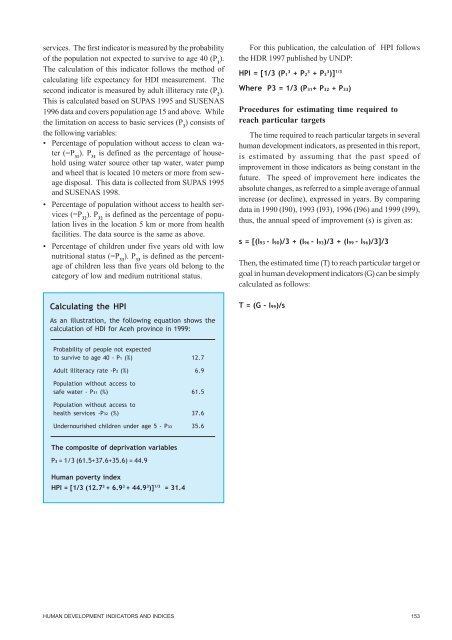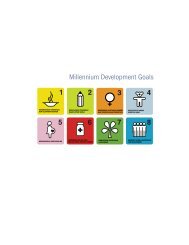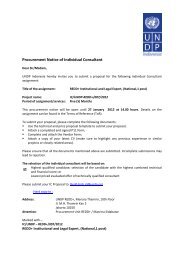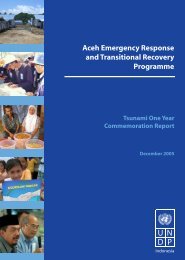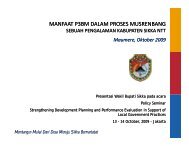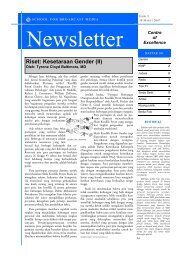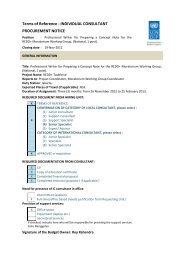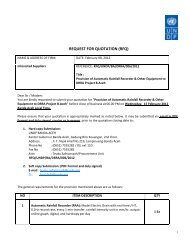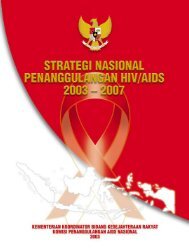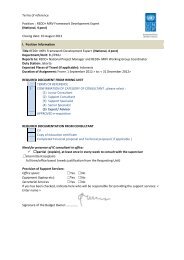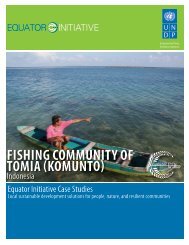services. The first indicator is measured by the probabilityof the population not expected to survive to age 40 (P 1).The calculation of this indicator follows the method ofcalculating life expectancy for HDI measurement. Thesecond indicator is measured by adult illiteracy rate (P 2).This is calculated based on SUPAS 1995 and SUSENAS1996 data and covers population age 15 and above. Whilethe limitation on access to basic services (P 3) consists ofthe following variables:• Percentage of population without access to clean water(=P 31). P 31is defined as the percentage of householdusing water source other tap water, water pumpand wheel that is located 10 meters or more from sewagedisposal. This data is collected from SUPAS 1995and SUSENAS 1998.• Percentage of population without access to health services(=P 32). P 32is defined as the percentage of populationlives in the location 5 km or more from healthfacilities. The data source is the same as above.• Percentage of children under five years old with lownutritional status (=P 33). P 33is defined as the percentageof children less than five years old belong to thecategory of low and medium nutritional status.Calculating the HPIFor this publication, the calculation of HPI followsthe HDR 1997 published by <strong>UNDP</strong>:HPI = [1/3 (P1 3 + P2 3 + P3 3 )] 1/3Where P3 = 1/3 (P31+ P32 + P33)Procedures for estimating time required toreach particular targetsThe time required to reach particular targets in severalhuman development indicators, as presented in this report,is estimated by assuming that the past speed ofimprovement in those indicators as being constant in thefuture. The speed of improvement here indicates theabsolute changes, as referred to a simple average of annualincrease (or decline), expressed in years. By comparingdata in 1990 (I90), 1993 (I93), 1996 (I96) and 1999 (I99),thus, the annual speed of improvement (s) is given as:s = [(I93 - I90)/3 + (I96 - I93)/3 + (I99 - I96)/3]/3Then, the estimated time (T) to reach particular target orgoal in human development indicators (G) can be simplycalculated as follows:T = (G - I99)/sAs an illustration, the following equation shows thecalculation of HDI for Aceh province in 1999:Probability of people not expectedto survive to age 40 - P1 (%) 12.7Adult illiteracy rate -P2 (%) 6.9Population without access tosafe water - P31 (%) 61.5Population without access tohealth services -P32 (%) 37.6Undernourished children under age 5 - P33 35.6The composite of deprivation variablesP3 = 1/3 (61.5+37.6+35.6) = 44.9<strong>Human</strong> poverty indexHPI = [1/3 (12.7 3 + 6.9 3 + 44.9 3 )] 1/3 = 31.4HUMAN DEVELOPMENT INDICATORS AND INDICES153
Definitions of Statistical TermsAccess to health facilities: the percentage of householdswhose place of residence is less than five kilometres from ahealth facility (hospital, clinic, community health centre,doctor, nurse, trained midwife, paramedic, etc.).Access to sanitation: the percentage of households who haveeither their own private toilet or access to public toilet facilities.Access to safe water: the percentage of households whoconsume mineral water, tap water, or water from water pumps,protected wheels, or protected springs.Average duration of illness: the average number of days ofillness of those who are sick.Births attended by modern health personnel : the percentageof children aged 0-4 whose birth was attended by modernmedical personnel (doctor, nurse, trained midwife, paramedic,etc.).Consumer price index (CPI): an index that indicates a relativecomparison between price level in the month of survey andprice level in the previous month, weighted by values ofconsumption in both months. CPI is calculated using amodified Laspeyres formula.Economic growth: the relative change in the real value ofgross domestic product over a certain time period.Education index: one of the three components of the humandevelopment index. This is based on the enrolment ratio andthe adult literacy rate. The index value is between 0 and 100.For details on how the index is calculated, see the technicalnote.Enrolment. The gross enrolment ratio is the number ofstudents enrolled at a given level of education, regardless ofage, as a percentage of the official school-age population forthat level. The net enrolment ratio is the number of childrenof official school-age enrolled in school as a percentage ofthe number of children of the official school-age population.The official school ages in <strong>Indonesia</strong> are 7-12 for primaryschool, 13-15 for junior high school, 16-18 for senior highschool, and 19-24 for tertiary education.Expenditure on food: the proportion of total expenditure usedto buy food.Gender empowerment measure (GEM): a composite indexusing variables constructed to measure the decision-makingpower of women in political and economic activities. TheGEM is based on three indicators: the percentage of thoseelected to parliament who are women, the percentage ofprofessionals, technicians, senior officials and managers whoare women, and women’s share of earned income. The indexvalue is between 0 and 100.Gender-related development index (GDI): a composite indexusing variables constructed to measure human developmentachievement taking into account gender disparity. The GDIcomponents are the same as the HDI components but adjustedto capture the disparity in achievement between men andwomen. The index value is between 0 and 100.Gross domestic product: the total amount of gross valueadded(total output of goods and services) produced by alleconomic sectors in a country during a certain period of time.Gross domestic product at constant prices: a calculation ofgross domestic product using on prices in a specific baseyear.Gross domestic product at current prices: the gross domesticproduct presented in current prices for the relevant year.Gross domestic product per capita: the value of gross domesticproduct divided by total mid-year population.Households with earth/dirt-floor house : the percentage ofhouseholds whose houses have mainly earth or dirt floors.<strong>Human</strong> development index (HDI) : a composite index basedon three indicators: longevity, as measured by life expectancyat birth; educational attainment, as measured by a combinationof adult literacy and mean years of schooling; and standardof living, as measured by per capita expenditure (PPP Rupiah).The index value is between 0 and 100.<strong>Human</strong> poverty index (HPI): a composite index that measuresdeprivations in three dimensions: longevity, knowledge andstandard of living.Illiteracy rate (adult): the proportion of adults who cannotread or write in Latin script or other scripts.Infant mortality rate (IMR) : the number of infants who diebefore reaching one year of age per 1,000 live births.154 INDONESIA HUMAN DEVELOPMENT REPORT <strong>2001</strong>


